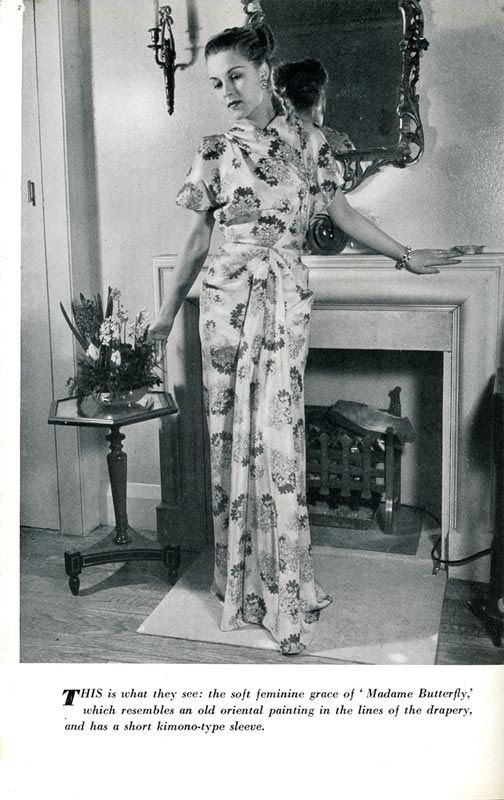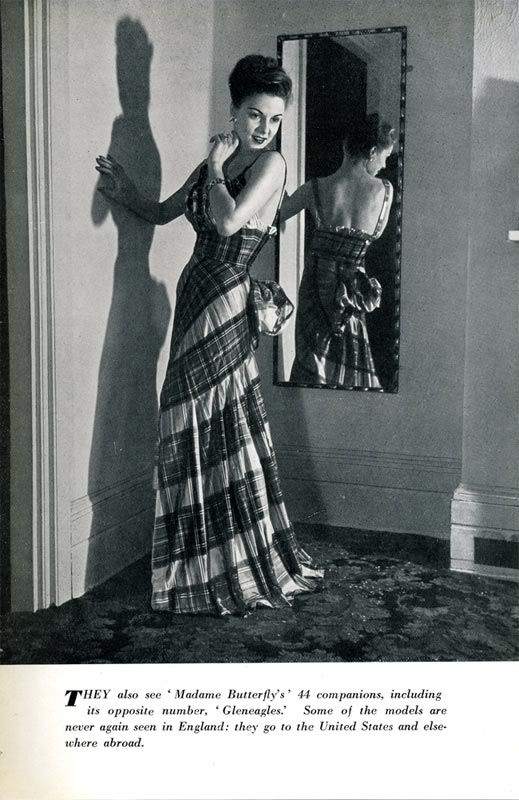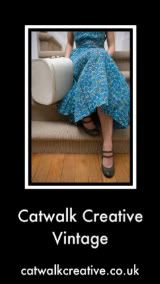"The Story of a Dress" by Lorraine Timewell, The Saturday Book 7, 1947, pp. 71-80.
Our dress was designed in England. The scissors point to the North, where the finest fabrics are made. Across the Channel lies Paris - a city of silk. Uniting the fashion centres of London and Paris is a current of industry and needlework. We send them woollens, they send us silk.
The dress begins in the mind's eye of the designer, Angele Delanghe. Her long, supple fingers are idle only when she is visualizing another design.
At the age of six Angele Delanghe was draping and pinning her doll's clothes, and she has been designing ever since. In 1914, when Belgium was invaded, she came to England as a refugee with her doll and a precious box of scraps and pieces. Now she is British.
Mr Strange, of Coudurier Fabrics, the great silk house, knows well how her imagination is fired by fine fabrics, and keeps her informed of his new arrivals.
In a tiny room she works with the selected fabric straight onto the dummy, its shoulder scarred with pin-marks. In picture one, she is concentrating her mind not on the checked silk, but on the floral printed silk lying on the table by Smuts the cat. She knows exactly what she wants to do with it, and in picture two begins to drape and pin. It is a fine silk in a pale oyster white, with burnt rose and grey outlined flowers scattered over it.
When the model has been assembled by Delanghe, it goes to the fitter in one of the workrooms, who cuts a pattern in 'toile' from the original. Then, under her supervision, the dress goes into the hands of the young sempstresses. In the picture above the moment of judgment has arrived. Miss Garner, the fitter, is taking the completed model to be tried on by a mannequin and viewed by Delanghe.
Audrey Kenney, the mannequin, with her head in a bag, is helped into the dress. The bag protects the fabric from lipstick and powder, and protects also her new 'hair-do.'
The date for the showing of the collections for each new fashion season is decided by agreement amongst the various designers, or couturiers. In London, they are known as the 'Big Ten' - the Incorporated Society of London Fashion Designers. Their present president is Norman Hartnell, and Delanghe is one of the 'Ten.' The eve of the collection finds the models facing their most formidable audience - the people who made them. The dress whose story we have been tracing (it has a name now, 'Madame Butterfly') passes the critical inspection of the staff. Then the clients arrive on the important day.
This is what they see: the soft feminine grace of 'Madame Butterfly,' which resembles an old oriental painting in the lines of the drapery, and has a short kimono-type sleeve.
They also see 'Madame Butterfly's' 44 companions, including its opposite number, 'Gleneagles.' Some of the models are never again seen in England: they go to the United States and elsewhere abroad.
And what next? The fabric manufacturers, the button makers, the fashion-supply companies, the printers, the Press, the fitters, the sempstresses, the secretaries, the telephonists have all been involved in the life of 'Madame Butterfly,' the demure navy and white checked afternoon dress (left), which we saw being designed on the stand, and their companions. Well, Angele Delanghe is looking abstracted. 'I am thinking of the next collection,' she says. And so it begins all over again.
_._._._._._._._._._._._._._._._._._._
This photo story appeared in the seventh edition of The Saturday Book - one of those compendiums of miscellany from the arts to anthropology, history and antiquities, social observation, folklore and all manner of diverting stuff - that were once so popular.
This edition was published in 1947, at pretty much the height of post-wartime austerity and a time when most women could only dream of a new evening gown made of silk, so its interesting to see that Ms Delanghe appeared to have no problem securing such scarce and valuable supplies. But then, as the piece points out, some (most?) of her output was destined for export.
Its great to see that the author, Lorraine Timewell, chose to feature Angele Delanghe rather than one of the more well known members of the London 'Big Ten' such as Hartnell, Hardy Amies or Digby Morton.
In fact I've found precious little about her, apart from these scraps:
Delanghe was an early member of the Incorporated Society of London Fashion Designers, formed in 1942, which included the Hon. Mrs Reginald Fellowes (its first president), Norman Hartnell, Peter Russell, Worth of London, Digby Morton, Hardy Amies, Bianca Mosca, Creed, Molyneux and Michael Sherard. (Information from In Vogue: Six Decades of Fashion by Georgina Howell and Exploring 20th Century London).
She was known for creating "soft feminine tailored clothing and beautiful romantic eveningwear and wedding gowns" (from The Cutting Edge: 50 Years of British Fashion, 1947-1997 by Amy de la Haye).
After the war she took over the Ladies' Outfitting and Ready to Wear Departments at Fortnum & Mason and "revitalized" them.
Former women's editor of the Yorkshire Post, Valerie Webster, recalls with palpable frustration that she was required to attend "the couture shows of people like Angele Delanghe and Lachasse who made tweedy suits and hefty jewel-encrusted evening gowns for the grouse moors and hunt ball scene." To be fair, this was probably in the early 1960s, and young Valerie was more interested in Mary Quant than grouse moors and hunt balls, and perhaps Delanghe was past her prime.
This little 'backstage' story of Angele Delanghe's work at least adds a little more to our knowledge of her.
















8 comments:
I think I've missed some blogs on my blogger homepage (should really start using google reader I guess!).
What a brilliant post. There's a feature from 1954 held at the BFI Mediatheque about the creation of a dress. Completely fascinating!
http://www.bfi.org.uk/whatson/brit_chic
Thanks Miss P!
That selection at the BFI looks essential - I'm itching to go and view them all.
And I did a post a while ago featuring a selection of British Pathe films about fashion designers - at least two of them have 'backstage' sequences:
http://tintrunk.blogspot.com/2010/01/elusive-fashion-designer-caught-on-film.html
Unfortunately, since I posted that, British Pathe have started including ads with their films, which is rather irritating, and popunder window ads too, ugh. Sorry about that - they're all worth the hassle to view though!
Hello, sorry to just drop into your blog like this...but your article on Angele Delanghe is about my great great aunt. If you wanted any more information about her I am sure I could ask my family :)
It was lovely to read what you had found, there doesn't seem to be much about her on the internet.
My email address is jessica2.delanghe@live.uwe.ac.uk if you had any questions, i will try and help as best as i can!
Jess, thank you for your comment!
You're right, there's very little about your couturier great great aunt online, despite her obvious skill and prestige.
In fact I was contacted by another family member of yours asking for information. Is it ok if I email you to give you the details? Perhaps you could give her the information that I couldn't supply her. But I won't forward anything unless you are happy to accept it.
that's absolutely fine!
Hi Jess. What I've done is send her your email address, since you offered it first! I thought that was best.
I do hope she gets in touch with you!
the printers, the Press, the fitters, the sempstresses, the secretaries, the classic sempstress
Hi,
I was fascinated to see this article on your blog, as I have an original copy of this edition of the Saturday Book, the reason being that my mother Elsie Wells, is the young seamstress shown at work with pressing iron in hand! She was 17 then and working for Angele Delanghe in Fortnum and Mason inspired her with a life long love of fashion. She used to make all our clothes and became a teacher of dressmaking and a champion quilter in later years.
Lovely to see this online after all these years!
Rebecca
Post a Comment